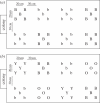Conspecifics as informers and competitors: an experimental study in foraging bumble-bees
- PMID: 21288951
- PMCID: PMC3145184
- DOI: 10.1098/rspb.2010.2659
Conspecifics as informers and competitors: an experimental study in foraging bumble-bees
Abstract
Conspecifics are usually considered competitors negatively affecting food intake rates. However, their presence can also inform about resource quality by providing inadvertent social information. Few studies have investigated whether foragers perceive conspecifics as informers or competitors. Here, we experimentally tested whether variation in the density of demonstrators ('none', 'low' and 'high'), whose location indicated flower profitability, affected decision-making of bumble-bees Bombus terrestris. Bumble-bees foraged on either 'simple' (two colours) or 'complex' (four colours) artificial floral communities. We found that conspecifics at low density may be used as sources of information in first flower choices, whereas they appeared as competitors over the whole foraging sequence. Low conspecific densities improved foragers' first-visit success rate in the simple environment, and decreased time to first landing, especially in the complex environment. High conspecific densities did not affect these behavioural parameters, but reduced flower constancy in both floral communities, which may alter the efficiency of pollinating visits. These results suggest that the balance of the costs and benefits of conspecific presence varies with foraging experience, floral community and density. Spatio-temporal scales could thus be an important determinant of social information use. This behavioural flexibility should allow bumble-bees to better exploit their environment.
This journal is © 2011 The Royal Society
Figures




References
-
- Chittka L., Thomson J. D., Waser N. M. 1999. Flower constancy, insect psychology, and plant evolution. Naturwissenschaften 86, 361–37710.1007/s001140050636 (doi:10.1007/s001140050636) - DOI - DOI
-
- Danchin E., Giraldeau L. A., Cézilly F. 2008. Behavioural ecology. New York, NY: Oxford University Press
-
- Wagner R. H., Danchin E. 2010. A taxonomy of biological information. Oikos 119, 203–20910.1111/j.1600-0706.2009.17315.x (doi:10.1111/j.1600-0706.2009.17315.x) - DOI - DOI
-
- Goulson D. 2003. Bumbleebees: behaviour and ecology. Oxford, UK: Oxford University Press
-
- Bonnie K. E., Earley R. L. 2007. Expanding the scope for social information use. Anim. Behav. 74, 171–18110.1016/j.anbehav.2006.12.009 (doi:10.1016/j.anbehav.2006.12.009) - DOI - DOI
MeSH terms
LinkOut - more resources
Full Text Sources

